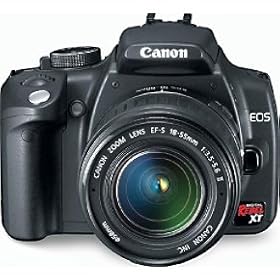 The Canon EOS 1D Mark II N features the same 8.2 megapixel CMOS sensor, DIGIC II image processor and 8.5 frames per second shooting speed of its predecessor, the Canon 1D Mark II. The primary changes are a new 2.5″ LCD screen, improved buffering characteristics, new Picture Style image parameters and the ability to write different formats simultaneously to SD and CF cards.
The Canon EOS 1D Mark II N features the same 8.2 megapixel CMOS sensor, DIGIC II image processor and 8.5 frames per second shooting speed of its predecessor, the Canon 1D Mark II. The primary changes are a new 2.5″ LCD screen, improved buffering characteristics, new Picture Style image parameters and the ability to write different formats simultaneously to SD and CF cards.
Reviews
The bottom line is always image quality, and the Mark II N does not disappoint. Most pro’s will opt to shoot in RAW mode, using software tools to adjust for the desired degree of sharpness, saturation and contrast. But the Mark II also produces high-quality finished JPEG images courtesy of its Picture Styles. While image noise is noticeable at sensitivities over ISO 800, ISO 1600 and 3200 produce quite usable images.
The major benefit that sets this apart from any other camera… 8.5 FPS. When reading that number, you don’t understand the impact until you actually have it in your hand and you hold down the shutter button… it’s awesome.
Overall, the EOS-1D Mark II n is an excellent tool. Its size, weight, and cost are justified not only by its speed and resolution, but by the fact that it is built to deliver those specs over the course of a long working life.
In a league by itself, the Mark II offers professional photographers extensive customization, excellent photo quality, and market-leading speed.
The 2.5″ LCD allows clearly a better view on images and histogram data. But overall we think that Canon could improve the organization of their histogram views. In our view the Nikon D2x allows a better inspection on the LCD while using a LCD of about the same size. We would propose to show the histograms as an overlay with both the luminance and the RGB channel histograms. The histograms have to be very bright and also the clipping indicators easy visible. But as said the LCD size is very nice.
I use an EOS 1D Mark II every day and love it and was fully prepared not to like this “N” model although the big LCD screen is obviously a cool touch. After using it under lots of real world conditions, I am convinced this is a significant enough upgrade to be worthwhile for anybody who wants to add a second camera body to their EOS digital system or a shooter who wants to move up from the 20D.
At a glance, the changes in the EOS-1D Mark II N, relative to the camera it replaces, should make what was already a really fine camera that much better. Canon deserves credit for implementing so many refinements to an existing product, some of which will make the camera a better tool for the photographer but which may not automatically help Canon sell more units. In other words, this upgrade to the EOS-1D Mark II seems to be more about adding truly useful features and refinements than it is about adding stuff that can be marketed easily.
Where to Buy
First off, consider going to your local camera store (and I don’t necessarily mean Wolf Camera at the mall). By going to your local camera store, you’re supporting your community and you just might build a lasting relationship with people you can rely on when you need some help or answers. If you’re buying online, I recommend sticking with Amazon, B&H Photo or Adorama. These three vendors are reliable, trustworthy and generally have the best (legitimate) prices. Additionally, purchasing your camera through these links helps support this site.
[tags]canon, 1d, mark IIn, review, features, specs, info[/tags]



 The Canon EOS Rebel XT is an 8.0-megapixel entry-level digital single-lens reflex camera. The Rebel XT is an upgraded version of the popular Canon EOS Digital Rebel, which was the first sub-$1000 digital SLR, introduced in 2003. The differences between the Rebel XT and the original Digital Rebel are significant and are present in almost all aspects of the camera. Many of the features ‘locked out’ by Canon in the original Digital Rebel were unlocked in this camera, so it has been subject to less unofficial ‘hacking’ to release the locked features. In addition to these unlocked features, a number of other improvements have been made. Some of the most significant upgrades include:
The Canon EOS Rebel XT is an 8.0-megapixel entry-level digital single-lens reflex camera. The Rebel XT is an upgraded version of the popular Canon EOS Digital Rebel, which was the first sub-$1000 digital SLR, introduced in 2003. The differences between the Rebel XT and the original Digital Rebel are significant and are present in almost all aspects of the camera. Many of the features ‘locked out’ by Canon in the original Digital Rebel were unlocked in this camera, so it has been subject to less unofficial ‘hacking’ to release the locked features. In addition to these unlocked features, a number of other improvements have been made. Some of the most significant upgrades include:
 The feel is unmistakably one of reliability. Canon’s new PowerShot S5 IS digital camera ergonomic grip fits firmly into the hand and the ready-for-action rubberized grip cover offers a substantial sense of reassurance. From its fast shutter-speed capabilities – up to1/3200 sec. – to the new accessory Hot-Shoe that accommodates a variety of Canon EX-series Speedlite flashes, the PowerShot S5 IS digital camera is a technological bridge between Canon’s advanced point and shoot compact digital cameras and its entry-level digital SLR cameras. For those seeking still greater optical capabilities, Canon offers an optional 1.5x teleconverter, a .75x wide converter and a close-up lens.
The feel is unmistakably one of reliability. Canon’s new PowerShot S5 IS digital camera ergonomic grip fits firmly into the hand and the ready-for-action rubberized grip cover offers a substantial sense of reassurance. From its fast shutter-speed capabilities – up to1/3200 sec. – to the new accessory Hot-Shoe that accommodates a variety of Canon EX-series Speedlite flashes, the PowerShot S5 IS digital camera is a technological bridge between Canon’s advanced point and shoot compact digital cameras and its entry-level digital SLR cameras. For those seeking still greater optical capabilities, Canon offers an optional 1.5x teleconverter, a .75x wide converter and a close-up lens. Despite its rich repertoire of photo features, the PowerShot S5 IS digital camera measures a mere 4.6 inches long, 3.15 inches high and 3.06 inches wide and tips the scales at less than 16 ounces. In stores beginning in early July 2007, the PowerShot S5 IS digital camera kit includes four AA alkaline batteries, a 32MB SD memory card, a USB interface cable, a stereo AV cable for audio/video output, and a full suite of Canon’s latest software applications. The PowerShot S5 IS digital camera carries an estimated selling price of $499.99.
Despite its rich repertoire of photo features, the PowerShot S5 IS digital camera measures a mere 4.6 inches long, 3.15 inches high and 3.06 inches wide and tips the scales at less than 16 ounces. In stores beginning in early July 2007, the PowerShot S5 IS digital camera kit includes four AA alkaline batteries, a 32MB SD memory card, a USB interface cable, a stereo AV cable for audio/video output, and a full suite of Canon’s latest software applications. The PowerShot S5 IS digital camera carries an estimated selling price of $499.99.

